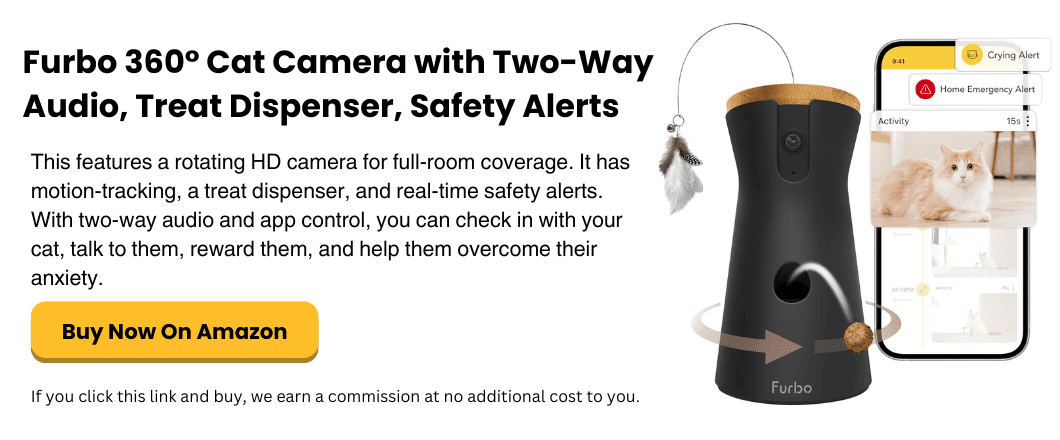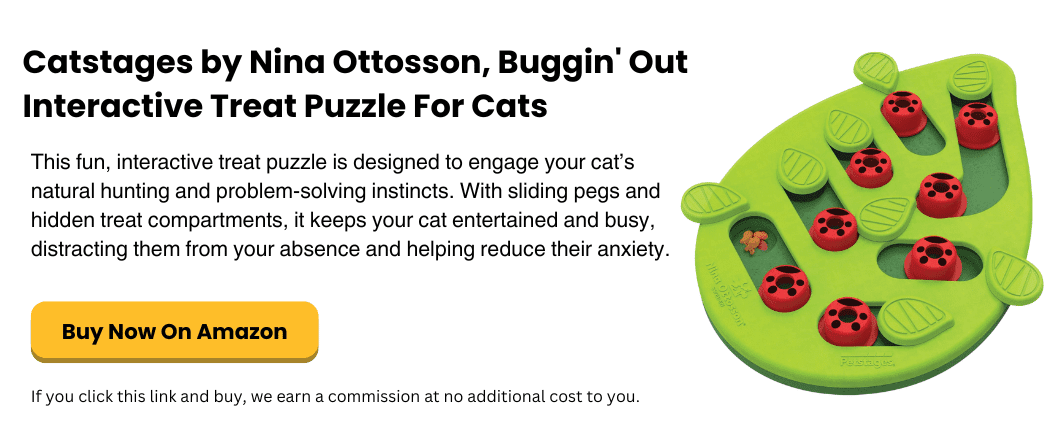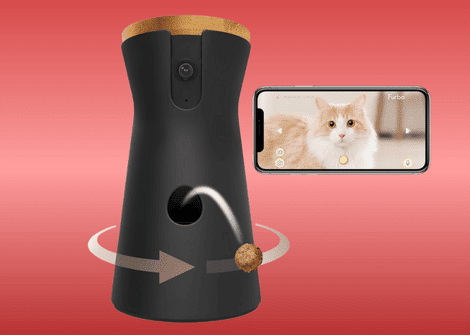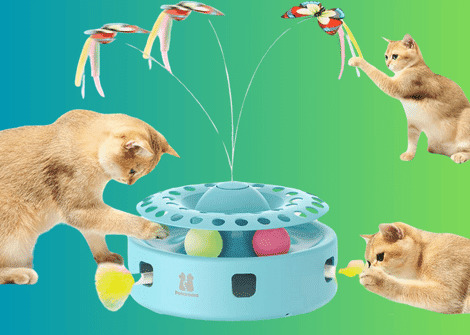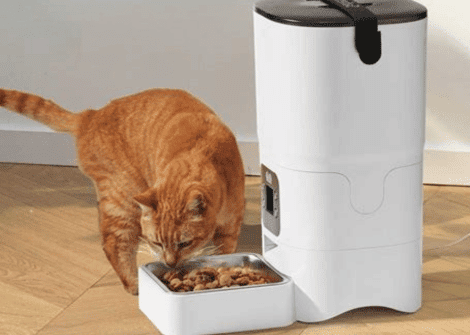How To Help Your Cat Overcome Separation Anxiety
Cats may have a reputation for being independent, but many form strong bonds with their owners and can experience distress when left alone – a condition known as Separation Anxiety.
Separation anxiety in cats can manifest in various ways, including excessive meowing, destructive behavior, or even refusing to eat when their owner is away. If your cat struggles with being alone, understanding the causes and solutions can help reduce their stress and create a more comfortable environment.
In this guide, we’ll explore the signs of separation anxiety, possible causes, and effective ways to ease your cat’s stress, including behavioral techniques, environmental enrichment, and the use of different products that can provide comfort and interaction while you’re away.

Table Of Contents
Recognizing Separation Anxiety In Cats
Causes of Separation Anxiety in Cats
Creating a Secure and Comfortable Environment
Behavioral Training To Reduce Anxiety
Smart Pet Technology To Help With Separation Anxiety
When To Seek Veterinary Help
Frequently Asked Questions About Separation Anxiety
Recognizing Separation Anxiety In Cats
Separation anxiety isn’t always obvious, especially since cats are known for their independent nature. However, there are several behavioral and physical signs that indicate distress when left alone:
- Excessive vocalization – Meowing, yowling, or crying loudly when you’re preparing to leave or while you’re away.
- Destructive behavior – Scratching furniture, knocking over objects, or tearing up household items.
- Litter box issues – Urinating or defecating outside the litter box, often on your belongings.
- Changes in appetite – Loss of interest in food, or binge-eating when left alone.
- Clinginess – Following you around the house and showing distress when you move toward the door.
- Overgrooming – Excessive licking or biting of their fur, leading to bald patches.
- Withdrawal or depression – Becoming less playful, hiding more often, or losing interest in usual activities.
If your cat exhibits these behaviors consistently when left alone, they are struggling with separation anxiety. The good news is that there are many ways to help them feel more secure and overcome this worrying condition.
Causes Of Separation Anxiety In Cats
Understanding why your cat experiences separation anxiety can help you find the best solutions. Some of the most common causes include:
-
Early weaning – Cats separated from their mother too soon may develop attachment issues.
-
Changes in routine – Moving to a new home, a change in your work schedule, or the loss of a family member (including a teenager going off to college), or even the arrival of another pet can trigger anxiety.
-
Lack of stimulation – Boredom and loneliness can increase stress levels.
-
Overdependence on humans – Some cats, especially those raised without other pets, become overly attached to their owners.
-
Genetic predisposition – Some breeds, like Siamese and Burmese cats, are naturally more social and therefore more prone to anxiety.
Once you determine the cause of your cat’s separation anxiety, you can begin implementing strategies to help them.
Creating a Secure and Comfortable Environment
One of the best ways to help your cat overcome their separation anxiety is to create an environment that feels safe, comfortable, and stimulating.
Here are some ways to do that:
1. Provide a Cozy Safe Space
Cats feel more secure when they have a dedicated spot that feels like their own personal retreat. You can help by:
-
Setting up a soft bed or enclosed cat cave in a quiet area.
-
Providing perches or hiding spots, like shelves or covered furniture, to create vertical space.
-
Using familiar scents, such as blankets or clothing with your scent, to provide comfort.
2. Use Calming Scents and Sounds
Soothing scents and sounds can help reduce anxiety when you’re not home. Try:
- Pheromone diffusers that mimic calming cat pheromones.
- Gentle background noise, like soft music or white noise, to create a relaxing atmosphere.
- Create a routine feeding and play schedule as well, so your cat feels a sense of stability.
3. Don’t Make Too Big a Deal Out of Leaving or Returning Home
One of the most effective yet often overlooked ways to ease a cat’s separation anxiety is by keeping your departures and returns low-key.
It’s natural to want to shower your cat with attention before you leave or rush to greet them when you get back, but making too big a deal out of these moments can actually increase your cat’s stress. Over time, your cat may then begin to associate your coming and going with emotional highs and lows, which can heighten their anxiety and make them more distressed during your absence.
Instead, try to create a calm and predictable routine. When you leave, do so quietly and without fanfare—avoid lingering goodbyes or overly affectionate send-offs. The same goes for when you return. Give your cat a few minutes to adjust before offering affection or interaction.
By staying calm and consistent, you help your cat understand that your absence is normal and nothing to fear.
4. Enrichment to Prevent Boredom
A bored cat is more likely to experience anxiety, so keeping their mind engaged can help. Consider:
-
Interactive toys that encourage problem-solving and play.
-
Puzzle feeders that make mealtime more stimulating.
-
Window perches or bird-watching stations to keep them entertained.
5. Try Natural Calming Supplements
If your cat’s anxiety is really severe, natural calming chews or supplements can help as a short-term solution.
These products often contain ingredients like L-theanine, chamomile, valerian root, or CBD derived from hemp—compounds known to promote relaxation without sedation.
Calming chews are typically easy to administer and may help ease your cat’s tension during times when you’re away for longer periods. While they can be a helpful part of your cat’s overall anxiety management plan, it’s important to speak with your veterinarian before starting any new supplement. Not all products are suitable for every cat, especially those with underlying health conditions or those already taking medications.
When used thoughtfully and as directed, calming chews and supplements can support a more balanced, peaceful state for your feline companion.
Behavioral Training to Reduce Anxiety
When it comes to easing separation anxiety in cats, behavioral training strategies can make a big difference.
These approaches focus on gently reshaping your cat’s responses to alone time, helping them feel more secure and less distressed when you’re away. From gradually increasing independence to creating enriching environments, behavioral techniques aim to build your cat’s confidence and reduce anxiety over time.
With patience and consistency, these strategies can lead to long-term improvements in your cat’s emotional well-being.
Gradual Desensitization
If your cat panics when you leave, start by practicing short absences and gradually increasing the time away from them:
-
Leave for 2-3 minutes at first, then return and reward your cat for staying calm.
-
Slowly extend your time away, helping your cat get used to being alone.
-
Avoid making departures and arrivals dramatic—keep them low-key to reduce anxiety.
Positive Reinforcement
Positive reinforcement is a powerful tool for shaping new, desirable behaviors in cats, especially when managing separation anxiety.
The idea is to help your cat form positive associations with being alone, such as:
- Reward your cat with treats and praise when they display calm behavior.
- Offer a special toy or treat only when you’re about to leave, creating a positive association with your absence.
Consistency is key—reinforce these moments immediately to strengthen the behavior over time. This gentle approach builds trust and confidence, encouraging your cat to feel more secure even when you’re not at home.
Avoid Reinforcing Clingy Behavior
It is vital that you avoid reinforcing any clingy behavior your cat might have, if you want them to overcome their separation anxiety. For example:
- If your cat follows you around constantly, try ignoring excessive attention-seeking and only give affection when they are calm.
- Teach them that being alone can be a positive experience by engaging them in solo activities, like interactive play – maybe with a smart toy or game – before you leave.
While it’s natural to want to comfort your cat, excessive attention can unintentionally encourage their anxious responses. Instead, aim for calm, low-key interaction with your cat.
Over time, this approach will create a more secure and well-adjusted feline companion.
Smart Products That Will Help with Your Cat's Separation Anxiety
Thanks to recent advancements in smart technology, there are now several products that will help you cat feel more secure while home alone, by providing comfort, interaction, and stimulation, and helping to ease their separation anxiety.
1. Smart Pet Cameras
Many smart cameras feature two-way audio, enabling you to talk to your cat and provide comfort with your voice, even when you’re not home. Some also include treat dispensers or interactive elements, giving your cat positive engagement while you’re away.
For cats that become anxious when left alone, the ability to hear their owner can make a big difference in their stress levels. Consistent interaction, even remotely, helps maintain a sense of connection and routine. Over time, this reassurance can ease feelings of loneliness and reduce destructive behaviors often associated with separation anxiety.
Investing in a smart cat camera can be a big turning point in helping your cat overcome their separation anxiety – and they provide real peace of mind to you.
2. Interactive Puzzle Toys
Interactive puzzle toys can be a simple yet highly valuable tool in helping reduce separation anxiety in cats. These budget-friendly toys stimulate your cat’s mind, encouraging them to stay focused and engaged while you’re away.
Mental enrichment plays a key role in reducing boredom and anxiety-related behaviors, such as excessive meowing or destructive scratching. Puzzle toys also promote independent play, helping your cat build confidence and feel more secure when alone.
The best of these toys involve problem-solving, which mimics natural hunting instincts and offers a sense of satisfaction. By offering a consistent source of stimulation and rewarding activity, interactive puzzle toys can create a calming routine that helps ease your cat’s stress and reinforces a positive experience during your absence.
3. Smart Cat Feeders
We already mentioned how important it is to create a routine feeding schedule when helping your cat overcome their separation anxiety. But we also know how difficult that can be in today’s world, where we are so busy and often away from home for long hours.
That’s why a smart cat feeder can be a valuable tool in managing separation anxiety in your cat. These devices allow you to schedule regular feeding times, whether you’re at home or away, to help maintain that predictable feeding routine that your cat needs.
The best smart feeders also have an in-built camera and offer two-way audio, so you can see you cat and talk to them while you’re away. As you can imagine, this sense of connection and consistency can ease your cat’s stress and reduce behaviors linked to anxiety, such as excessive meowing or pacing. By taking the pressure off feeding times and adding a layer of emotional support, smart feeders can make your absence feel less disruptive to your cat’s daily life, and offer you much-needed peace of mind.
4. Smart Water Fountains
Smart cat water fountains can quietly support your cat’s emotional well-being when they’re dealing with separation anxiety.
These fountains provide a consistent, flowing water source that mimics natural streams, which many cats find calming. The gentle sound and motion can offer a sense of companionship and routine, helping reduce feelings of stress or loneliness when you’re not around.
Many smart models also include features like scheduled water circulation, filtration systems, and water level monitoring, ensuring your cat stays hydrated in your absence. Staying well-hydrated not only supports their physical health but also helps maintain emotional balance.
By providing a sense of normalcy and security, smart water fountains can be a simple yet effective tool for easing anxiety in cats.
When to Seek Veterinary Help
If your cat’s separation anxiety is severe and nothing seems to help, then you’ll need to consult a veterinarian. They can:
-
Rule out any medical conditions that might be contributing to the behavior.
-
Recommend natural calming supplements or, in extreme cases, prescription anxiety medications.
-
Offer professional behavioral guidance tailored to your cat’s specific needs.
Frequently Asked Questions About Separation Anxiety In Cats
If you still have some questions about Separation Anxiety, here are the most frequently asked questions that hopefully will answer your queries and concerns.
Can separation anxiety in cats go away on its own?
Mild cases may improve with time, but the majority of cats with separation anxiety benefit from intentional behavioral support, routine adjustments, and environmental enrichment. Without intervention, anxiety can persist or even worsen.
Is it okay to get another cat to keep my cat company?
Not always. While some cats enjoy the company of other pets, others may become more stressed. It’s important to consider your cat’s temperament and whether they’ve responded well to other animals in the past.
How long does it take to help a cat overcome separation anxiety?
There’s no set timeline. Some cats show improvement within weeks with consistent strategies, while others may require months of gradual desensitization and behavioral changes. Patience and consistency are key.
Can kittens experience separation anxiety?
Yes, kittens can develop separation anxiety, especially if they are weaned too early or have had limited social exposure. Creating a secure and enriched environment early on helps build independence.
Does leaving the TV or radio on help cats with anxiety?
For some cats, the background noise of a TV or radio can provide comfort and reduce the feeling of being alone. Soothing music or nature sounds may help create a calm atmosphere.
However, you will probably find that you need to use other strategies as well, to help your cat fully overcome their separation anxiety.
Are there any techniques I can use before leaving the house?
Yes, you can establish a calm goodbye routine, avoid dramatic exits, and use interactive playtime before leaving to burn off nervous energy. Gradually increasing alone time in short intervals can also help.
Final Thoughts
Helping a cat with separation anxiety requires patience, consistency, and a mix of strategies to create a secure, enriching environment. By recognizing the signs of distress, providing comforting spaces, using positive reinforcement, and incorporating smart products, you can help your cat feel safe and confident even when you’re not home.
Every cat is different, so finding the right approach may take time, but with love and dedication, you can ease their anxiety and improve their overall well-being.
More Reading
Smart cat cameras allow you to watch, interact with, and care for your cat remotely. They connect to WiFi, and offer live video streaming, two-way audio, and even treat dispensers.
Smart cat toys aren’t just about entertainment—they can help prevent boredom, encourage exercise, and even reduce stress-related behaviors, such as separation anxiety.
It’s essential to feed your cat the right amount of food in the right number of portions. Our Guide helps you understand how to keep your cat healthy and happy.


